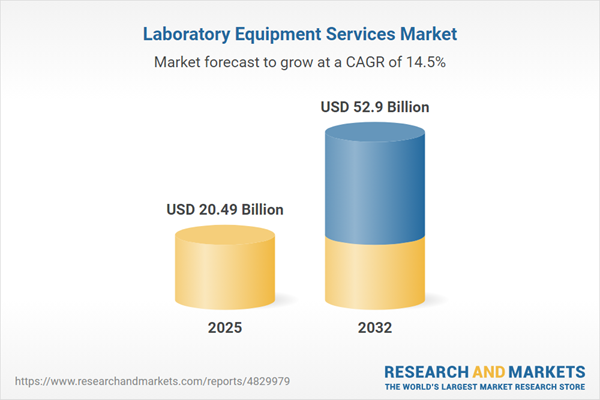Speak directly to the analyst to clarify any post sales queries you may have.
The Laboratory Equipment Services Market is experiencing rapid evolution, shaped by digital innovation, shifting regulatory landscapes, and increasingly complex end-user requirements. This in-depth report brings clarity to key trends, competitive dynamics, and actionable strategies essential for decision-makers navigating this dynamic sector.
Market Snapshot: Laboratory Equipment Services Market Growth and Outlook
In 2024, the Laboratory Equipment Services Market achieved revenues of USD 17.94 billion and is set to reach USD 20.49 billion by 2025, reflecting strong year-on-year expansion. The sector is projected to sustain momentum with a compound annual growth rate (CAGR) of 14.47%, with total market value forecasted at USD 52.90 billion by 2032. This growth is propelled by laboratories’ increasing reliance on outsourced calibration, maintenance, and value-added services to support operational efficiency, compliance, and technological advancement.
Scope & Segmentation
This report provides a comprehensive examination of the Laboratory Equipment Services Market, segmented by critical factors that influence purchasing and operational strategy:
- Service Types: Calibration (off-site and on-site), Installation & Commissioning, Maintenance & Repair (corrective and preventive), Training & Consultancy, Validation
- Equipment Categories: Centrifuges, Chromatography Systems, Furnaces & Ovens, Microscopes, Refrigerators & Incubators, Spectrometry Systems
- Pricing Models: Contract Based, Pay Per Service, Subscription
- End-Use Applications: Academic & Research, Biotechnology, Clinical Diagnostics, Environmental Testing, Food & Beverage Processing, Pharmaceutical Manufacturing
- Sales Channels: OEM, Third-Party Providers
- Geographic Regions: Americas (including North America and Latin America), Europe, Middle East & Africa, Asia-Pacific
Technological influences covered include IoT-enabled monitoring, remote diagnostics, and predictive analytics for optimized asset management and minimized equipment downtime.
Key Takeaways for Industry Leaders
- The progression of digital transformation is shifting laboratory service models, enabling predictive maintenance, improved technician routing, and real-time equipment monitoring.
- Flexible approaches are defining new service contracts, with subscription bundles and outcome-based agreements replacing traditional support methods in response to evolving client expectations.
- Quality assurance, regulatory compliance, and rapid response capabilities remain crucial to end-user satisfaction, especially in regulated and high-throughput laboratory environments.
- Providers are differentiating by integrating value-added training, consultancy, and validation services, satisfying diverse technical needs across academic, industrial, and biopharma applications.
- Regional dynamics drive demand for localized support, multilingual training, and inventory investment, particularly in emerging hubs and markets with specific compliance requirements.
Tariff Impact on Laboratory Equipment Service Providers
Recent United States tariffs on imported laboratory equipment and components have increased procurement costs and altered supply chain strategies. Providers are responding by renegotiating supplier contracts, realigning distribution centers closer to key users, and expanding domestic sourcing to mitigate volatility. These shifts challenge organizations to achieve greater operational agility while fine-tuning service pricing to safeguard margins and maintain competitiveness.
Methodology & Data Sources
This study leverages a rigorous approach, incorporating primary qualitative interviews with industry experts and laboratory leaders, complemented by secondary analysis of technical reports and regulatory documentation. Data triangulation and systematic segmentation ensure robust, actionable insights aligned with real-world practices.
Why This Report Matters: Guiding Effective Strategic Decisions
- Offers an executive perspective on how digital transformation and regulatory forces impact laboratory equipment services globally.
- Enables benchmarking against leading providers and evaluation of innovations in predictive maintenance and service delivery.
- Equips decision-makers with frameworks for navigating complex tariff scenarios and regional market nuances.
Conclusion
Senior decision-makers can leverage this report to clarify industry trends, evaluate technology-driven opportunities, and refine service delivery models. A strategic, data-driven approach is essential to maintain competitive advantage in a transforming market landscape.
Additional Product Information:
- Purchase of this report includes 1 year online access with quarterly updates.
- This report can be updated on request. Please contact our Customer Experience team using the Ask a Question widget on our website.
Table of Contents
3. Executive Summary
4. Market Overview
7. Cumulative Impact of Artificial Intelligence 2025
Companies Mentioned
The companies profiled in this Laboratory Equipment Services market report include:- Thermo Fisher Scientific Inc.
- Danaher Corporation
- Agilent Technologies, Inc.
- Mettler-Toledo International Inc.
- PerkinElmer, Inc.
- Shimadzu Corporation
- Waters Corporation
- Bruker Corporation
- Bio-Rad Laboratories, Inc.
- Hitachi Ltd.
Table Information
| Report Attribute | Details |
|---|---|
| No. of Pages | 196 |
| Published | October 2025 |
| Forecast Period | 2025 - 2032 |
| Estimated Market Value ( USD | $ 20.49 Billion |
| Forecasted Market Value ( USD | $ 52.9 Billion |
| Compound Annual Growth Rate | 14.4% |
| Regions Covered | Global |
| No. of Companies Mentioned | 11 |









